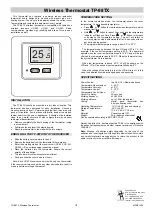
4
5
Installation considerations
• The Smart Thermostat HD requires 24 VAC power.
There is no option for a battery-powered mode.
Power is supplied via a common wire, typically
identified as C.
Location
• If replacing an existing thermostat, the new
Smart Thermostat HD can be mounted in its place.
If a new location is desired it will be necessary
to move the wiring.
• New installations and relocations should follow the
accompanying guidelines to ensure the most accurate
temperature reading and ease of use.
• Mount on an inside wall, approximately 5 ft. (1.5 m)
above the floor in a frequently used room.
• Do not install in locations near appliances or devices
that affect the local temperature such as televisions,
lamps, or dryers.
• Avoid areas that are exposed to large temperature
variances, such as: direct sunlight, near an AC unit,
above or below auxiliary heat and air vents, and drafts
from windows or exterior doors.
• Be aware of what is on the other side of the wall where
the installation is occurring. Do not install on walls
adjacent to unheated rooms, stoves, or housing hot
water pipes. Exterior walls are also not ideal locations
for installation.
• Damp areas will not only affect the humidity reading
but could lead to corrosion and shorten the lifespan
of the thermostat.
• Install in a location with good air circulation.
Stagnant air will not accurately reflect the rate of
temperature change in the room.
• Avoid areas behind open doors, corners, and alcoves.
• Wait until construction and painting are finished
before installing.
Preparation
❶
If you will add the Smart Thermostat HD
to a Z-Wave network, power on the controller
and verify it is communicating.
• If the Z-Wave network supports SmartStart,
use MobileTech to scan the QR code found on the
Thermostat or the box.
❷
Test the existing system.
• Verify that the heating and/or cooling system is
operating properly before you try to install the new
Smart Thermostat HD.
CAUTION: Do not test the system by shorting
electric terminals. Do not test the cooling system if
it is cold outside, as this may harm the compressor.
Continued next page →
❸
Turn off power to the HVAC unit.
• Turn all heating and cooling systems off.
This can be done at the circuit breaker.
CAUTION: Do not remove the existing thermostat until
power has been turned off at the circuit breaker.
❹
Remove the existing thermostat.
• Remove the cover from the existing thermostat.
Do not disconnect the wires yet.
• Make sure the wires are identified correctly. If you have
an unidentified wire, it may be necessary to identify
where the wire connects to the heating or air
conditioning equipment.
CAUTION: Wiring can vary for each manufacturer.
Identify all wiring designations before removing
it from the existing thermostat.
• Take a picture of the wires before you detach them from
the existing thermostat for future reference.
• After all wires are identified and a picture has been
taken, disconnect all the wires and remove the
existing thermostat. Remember to secure the wires
so they do not fall into the wall.
❺
Prep wires (if needed).
• Ensure the wires are a proper gauge between
16-24 AWG (1.3 – 0.5 mm)
• Make sure wires have exposed straight ends of the
appropriate length.
❸



























